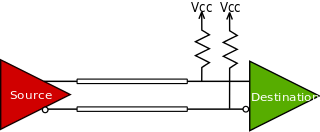This article includes a list of general references, but it lacks sufficient corresponding inline citations .(January 2015) |

In electronic logic circuits, a pull-up resistor (PU) or pull-down resistor (PD) is a resistor used to ensure a known state for a signal. [1] It is typically used in combination with components such as switches and transistors, which physically interrupt the connection of subsequent components to ground or to VCC. Closing the switch creates a direct connection to ground or VCC, but when the switch is open, the rest of the circuit would be left floating (i.e., it would have an indeterminate voltage).
Contents
For a switch that is used to connect a circuit to VCC (e.g., if the switch or button is used to transmit a "high" signal), a pull-down resistor connected between the circuit and ground ensures a well-defined ground voltage (i.e. logical low) across the remainder of the circuit when the switch is open. For a switch that is used to connect a circuit to ground, a pull-up resistor (connected between the circuit and VCC) ensures a well-defined voltage (i.e. VCC, or logical high) when the switch is open.
An open switch is not equivalent to a component with infinite impedance, since in the former case, the stationary voltage in any loop in which it is involved can no longer be determined by Kirchhoff's laws. Consequently, the voltages across those critical components (such as the logic gate in the example on the right), which are only in loops involving the open switch, are undefined, too.
A pull-up resistor effectively establishes an additional loop over the critical components, ensuring that the voltage is well-defined even when the switch is open.
For a pull-up resistor to serve only this one purpose and not interfere with the circuit otherwise, a resistor with an appropriate amount of resistance must be used. For this, it is assumed that the critical components have infinite or sufficiently high impedance, which is guaranteed for example for logic gates made from FETs. In this case, when the switch is open, the voltage across a pull-up resistor (with sufficiently low impedance) practically vanishes, and the circuit looks like a wire connected to VCC. On the other hand, when the switch is closed, the pull-up resistor must have sufficiently high impedance in comparison to the closed switch to not affect the connection to ground. Together, these two conditions can be used to derive an appropriate value for the impedance of the pull-up resistor but usually, only a lower bound is derived assuming that the critical components do indeed have infinite impedance. A resistor with low resistance (relative to the circuit it's in) is often called a "strong" pull-up or pull-down; when the circuit is open, it will pull the output high or low very quickly (just as the voltage changes in an RC circuit), but will draw more current. A resistor with relatively high resistance is called a "weak" pull-up or pull-down; when the circuit is open, it will pull the output high or low more slowly, but will draw less current. Keep in mind that this current, which is essentially wasted energy, only flows when the switch is closed, and technically for a brief period after it is opened until the charge built up in circuit has been discharged to ground.









